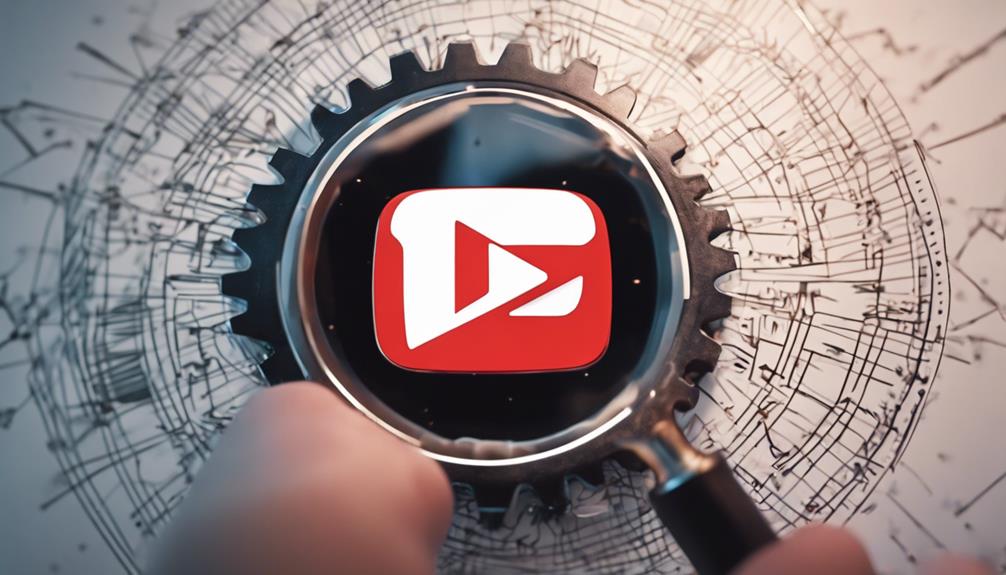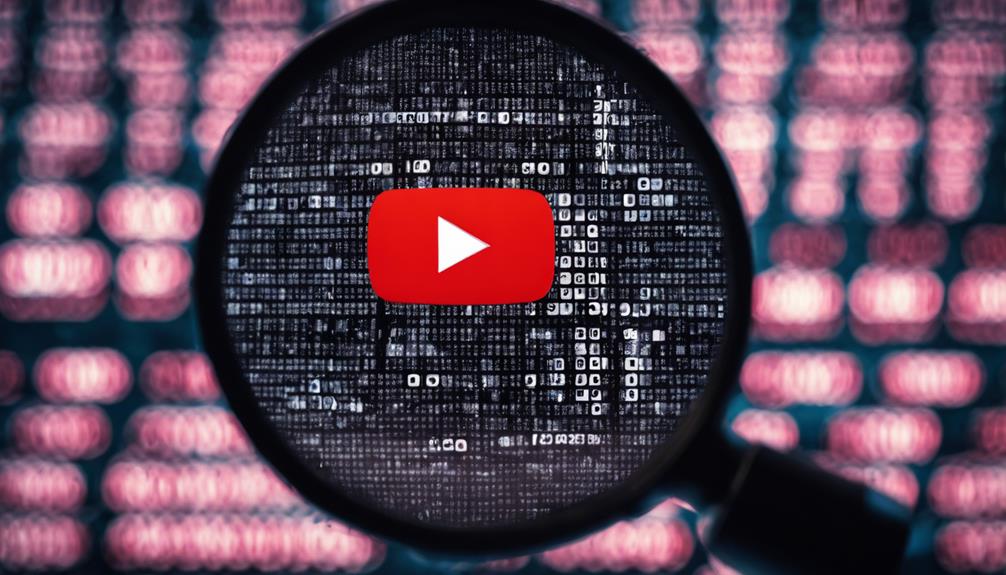
How do you tell if a YouTube video is boosted?
Peeling back the layers of a YouTube video’s success can be akin to dissecting an onion, where each layer may reveal a different story.
As you navigate this digital landscape, you might wonder how to distinguish organic growth from artificial boosting. What are the telltale signs? Can social signals, comment patterns, or the like-to-dislike ratio shed any light?
How about audience retention or sudden spikes in channel subscriber growth? Is it possible that there are tools to detect such manipulation?
As we explore this topic further, these questions will guide our in-depth analysis.
Key Takeaways
- Analyzing engagement metrics like view counts, likes, shares, and comments can unveil potential artificial boosting.
- Investigating comment patterns, frequency, and sentiment consistency aids in detecting manipulated video content.
- Higher audience retention rates, organic subscriber growth, and video length reveal the authenticity of a YouTube video.
- Tools like video analytics and careful scrutiny of sudden spikes in engagement metrics help identify boosted videos.
Understanding YouTube’s Algorithm

To fully grasp how boosted YouTube videos work, you first need to comprehend YouTube’s complex algorithm, which controls every aspect of the user experience on the platform. This algorithm isn’t just a mathematical formula; it’s a dynamic code that adapts based on user behavior, trends, and a myriad of other factors. It’s a system that’s continually learning and evolving, making it a challenge to conquer.
Algorithm manipulation plays a crucial role in boosting YouTube videos. It’s all about understanding and leveraging the system to increase visibility, reach, and engagement. The algorithm decides which videos appear in YouTube’s recommendations, a prized spot that can lead to a substantial increase in views. Your job is to figure out how to make your videos appealing to the algorithm.
This doesn’t mean you should resort to underhanded tactics; YouTube frowns on attempts to game the system. Instead, focus on creating high-quality content that resonates with your audience. Be consistent, use keywords wisely, and engage with your viewers. In doing this, you’re not just manipulating the algorithm, but working with it to maximize your YouTube success. The algorithm is your ally, not your adversary.
The Role of Social Signals
In the realm of YouTube’s algorithm, social signals play a critical role, acting as indicators of your video’s popularity and relevance. They’re a window into how viewers are interacting with your content. But it’s essential to understand the variations of these signals and how to detect bot interactions, to ensure you’re basing your analysis on genuine engagement.
Social Signal Variations range from likes and dislikes to shares, comments, and even the duration of views. Each of these signals contributes differently to the algorithm, and understanding their individual impact can help you better interpret your video’s performance.
Simultaneously, Detecting Bot Interactions is crucial in determining whether the engagement is organic or manipulated. Bots can generate false signals that may skew your analysis, leading to inaccurate conclusions about your video’s popularity.
| Social Signal Variations | Detecting Bot Interactions |
|---|---|
| Likes/Dislikes | Look for rapid, large number of interactions |
| Shares | Check for patterns in the sharing activity |
| Comments | Analyze the relevance and authenticity of the comments |
| View Duration | Bots typically have shorter view durations |
Artificial View Count Indicators

Often, you’ll come across videos with suspiciously high view counts, which could be a result of artificial boosting. Recognizing these artificially inflated view counts requires an analytical, detail-oriented approach.
To spot these discrepancies, you need to consider:
- Viewer Demographics: An unusual mismatch between the video content and the viewer demographics might indicate artificial boosting. For example, a video about men’s grooming products getting most views from female demographics would be suspicious.
- Click Through Rates: A video with a high view count but low click-through rate is a red flag. This disconnect might suggest that views are being artificially increased, but actual viewer engagement is low.
- Sudden Spikes: If a video’s view count suddenly spikes without a corresponding increase in likes or comments, it’s likely that these views aren’t organic.
- Video Engagement: A video with a high view count but low engagement (likes, comments, shares) is another indicator of artificial boosting.
Comment Analysis Techniques
You can gain insights into a YouTube video’s authenticity by using comment analysis techniques.
Decoding comment patterns, identifying spam comments, and understanding the role of comment sentiment are key in this process.
Decoding Comment Patterns
Peering into the realm of comment patterns can reveal valuable insights about a YouTube video’s authenticity. This involves careful observation of comment frequency and viewer demographics.
- Comment Frequency: A sudden surge in comments might indicate a boosted video. Genuine engagement usually results in a consistent flow of comments over time.
- Viewer Demographics: Comments from a diverse demographic are a positive sign. If comments are predominantly from a narrow demographic, it may suggest artificial boosting.
- Time of Commenting: Authentic videos have comments spread across different times. If most comments are posted at the same time, be suspicious.
- Relevance: Genuine comments have a connection to the video content. Irrelevant comments often indicate boosting.
Decoding comment patterns can be a powerful tool in understanding the legitimacy of a video.
Identifying Spam Comments
Building on the understanding of comment frequency and viewer demographics, it’s crucial to zero in on the content of the comments themselves – a technique that aids in the identification of spam comments. Spam detection techniques involve analyzing the repetitiveness, relevance, and grammar in comments.
For instance, comments that repeat the same phrase or link multiple times are likely spam. Similarly, comments that don’t align with the video content may be spam. Poor grammar can also indicate a spammy comment, as many are auto-generated.
User verification methods are another effective tool in spam identification. Verified users are less likely to post spam, so comments from unverified users might warrant closer scrutiny. By employing these techniques, you can more accurately identify boosted videos.
Role of Comment Sentiment
Delving into the realm of comment sentiment, it’s essential to note its significant role in determining whether a YouTube video has been artificially boosted or not. This process uses emotional polarity analysis and sentiment classification algorithms to examine user comments.
- Emotional Polarity Analysis: This aspect measures the positivity or negativity of comments. An unnatural surge in overly positive comments may indicate boosting.
- Sentiment Classification Algorithms: They categorize comments into positive, negative, or neutral. An imbalance may hint at manipulation.
- Volume of Sentiments: A sudden increase in sentiment-laden comments can be a red flag.
- Consistency of Sentiment: Regular viewers tend to have varying sentiments. If these are uniformly positive or negative, be suspicious.
Thus, understanding comment sentiment can help unveil boosted content.
Dissecting Like-to-Dislike Ratios
In the realm of YouTube, understanding the like-to-dislike ratio can provide valuable clues about a video’s authenticity. This simple metric is a powerful tool that gauges a video’s popularity and the level of genuine engagement it’s receiving. When this ratio is skewed, it may suggest artificial boosting or manipulation.
Let’s dissect this further. A high ratio of likes to dislikes typically signifies a well-received video. But, if this ratio is excessively high with a significant viewer count, it might indicate that dislikes are being suppressed, altering the dislike influence. On the other hand, a high number of dislikes may suggest controversial content, but again, if it’s disproportionate, it might be a sign of targeted dislike campaigns.
To confirm your suspicions, cross-verify with comments and views. If a video has a significant number of likes but few views or comments, it’s likely that the engagement isn’t genuine. Be a discerning viewer. Remember, an exceptionally high like-to-dislike ratio is as suspicious as an exceptionally low one.
Importance of Audience Retention

Often overlooked, audience retention plays a crucial role in deciphering the organic nature of a YouTube video’s engagement. Understanding retention metrics allows you to gauge the user interaction, a key parameter in identifying whether a video’s popularity is artificially boosted or genuinely earned.
Here are four reasons why audience retention is essential:
- Viewer Interest: Higher retention rates often signify that viewers find the content engaging and worthwhile. A sudden drop in viewership could indicate a less interesting portion of the video.
- Algorithm Preference: YouTube’s algorithm favors videos with high retention rates, as it interprets this as high-quality content.
- Revenue Generation: Advertisers are more likely to invest in videos where users stay engaged for longer periods, enhancing the video’s revenue potential.
- User Interaction: Audience retention is closely linked to user interaction. Videos with high retention rates usually have more likes, shares, and comments – authentic indicators of engagement.
Observing Channel Subscriber Growth
While understanding audience retention is vital, it’s equally important to monitor the growth of a channel’s subscribers, as it can offer valuable insights into the authenticity of a video’s popularity.
A sudden surge in subscribers may suggest that a video is gaining genuine traction. However, it’s essential to scrutinize this growth. Is it consistent? Does it align with the video’s quality, content, and length? Keep an eye on subscriber demographics as well. An influx of subscribers from disparate geographic locations or age groups could indicate artificial boosting.
The video length impact is another crucial aspect. Longer videos often foster more meaningful engagement and, in turn, can lead to a more organic growth in subscribers. Conversely, short videos might attract a quick, less committed audience, which could potentially inflate the subscriber count artificially.
Patterns in Video Sharing

Analyzing the patterns in video sharing can provide you with clear indicators of whether a YouTube video’s popularity is authentic or artificially boosted. This can be better understood by looking at certain aspects of the videos such as the influence of video length and virality triggers.
- Influence of Video Length: Videos of moderate length often have a higher chance of being shared, as they maintain viewer interest without overwhelming them with information. If a video of extreme length (either too short or too long) rapidly gains popularity, it may be a red flag.
- Rapid Share Increase: An unnatural, sudden spike in shares, especially in a short timeframe, can indicate artificial boosting.
- Ignoring Virality Triggers: Virality triggers like emotional connection or relevance to current trends often cause videos to be shared widely. If a video lacks these but is still popular, it’s worth a second look.
- Crowded Sharing Sources: If most shares are coming from a single platform or user group, it could suggest coordinated efforts to boost the video.
Tools for Detecting Boosted Videos
To spot a boosted YouTube video, you’ll need the right tools at your disposal.
First, you need to understand video analytics and how they can highlight unusual patterns of engagement.
Then, you must learn to identify signs of fake engagement, which often indicate that a video’s popularity has been artificially inflated.
Understanding Video Analytics
Diving into video analytics can significantly aid in detecting boosted YouTube videos, revealing patterns and anomalies that wouldn’t be apparent from a surface-level view. Your understanding of analytics interpretation and video performance metrics will be crucial in this endeavor.
Here are four steps to guide you:
- Scrutinize the video’s view count and watch time. A sudden spike could suggest boosting.
- Check the like-dislike ratio. An unusually high ratio might indicate manipulation.
- Look at the comments. Genuine engagement often involves meaningful discussion.
- Examine subscriber growth. A sudden increase without corresponding engagement is suspicious.
Identifying Fake Engagement
After getting a handle on video analytics, your next step is to arm yourself with the right tools to detect fake engagement on YouTube videos.
Look out for bot activity detection, a key indicator of artificial engagement.
Sophisticated tools can identify irregularities in viewing patterns, sudden spikes in likes or comments, and suspiciously similar user activity.

